Chapter 54
The Fox Winrock and
Lawrence of Arabia
The Fox Winrock and
Lawrence of Arabia
This is another story that nobody believes.
For this one, you just either have to take my word for it, or not.
Up to you.
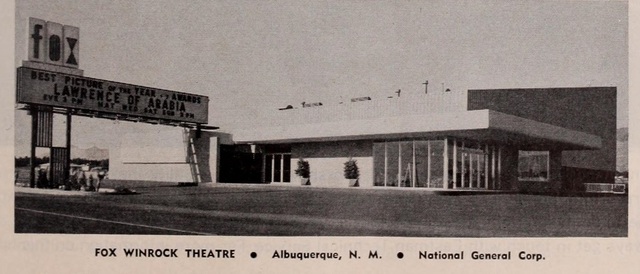
Yes, though freestanding and rather a long walk from the rest of Winrock Shopping Center, this was truly on the grounds of the Winrock Shopping Center. All the buildings were freestanding, and all were rather a distance from one another, to make parking more convenient. In the 1970’s, more stores were added and much of the center was enclosed, but the Fox always remained separate.
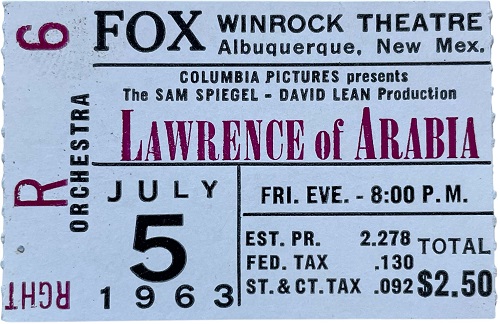
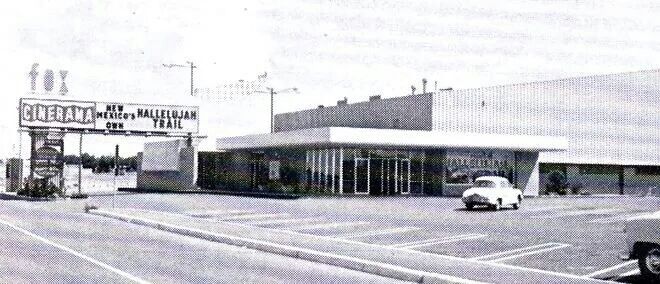
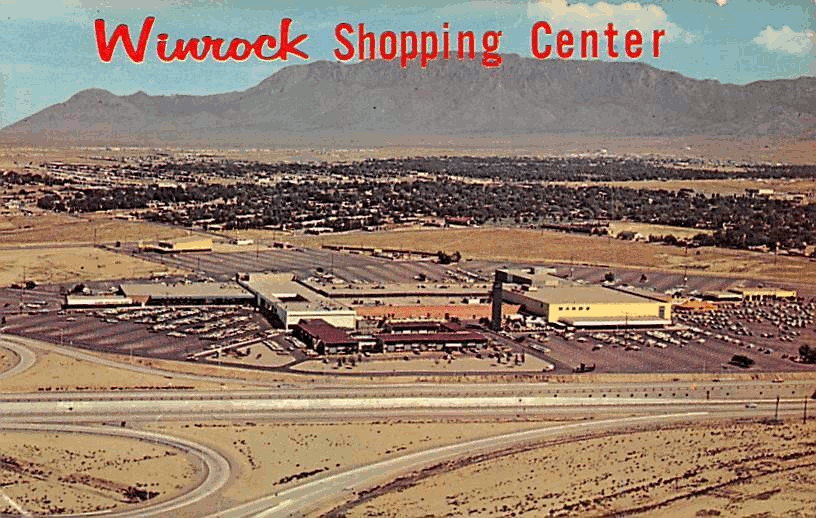
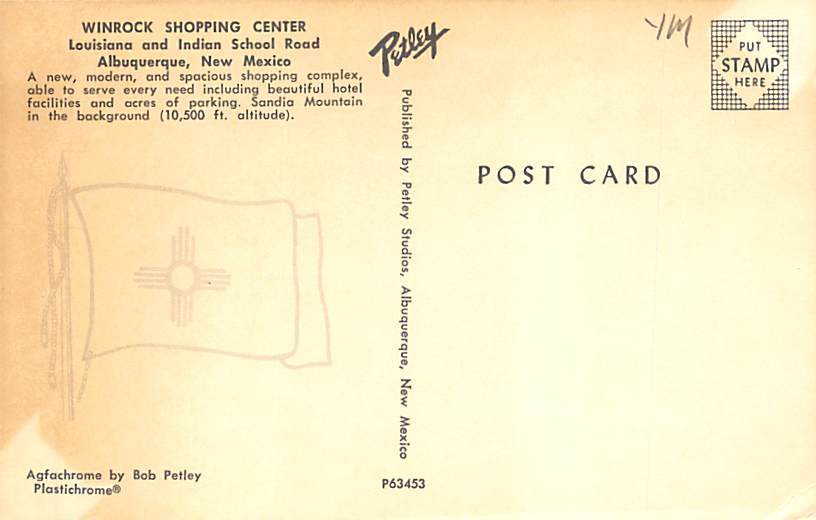
Arrow pointing to the Fox Winrock cinema.
This postcard, surely from 1963, disagrees with my memory.
My memory is that few of the buildings were connected.
From the air, it might have looked different,
since the disconnected buildings shared roofs over the common walkways.
Even so, this photo proves my memory wrong.
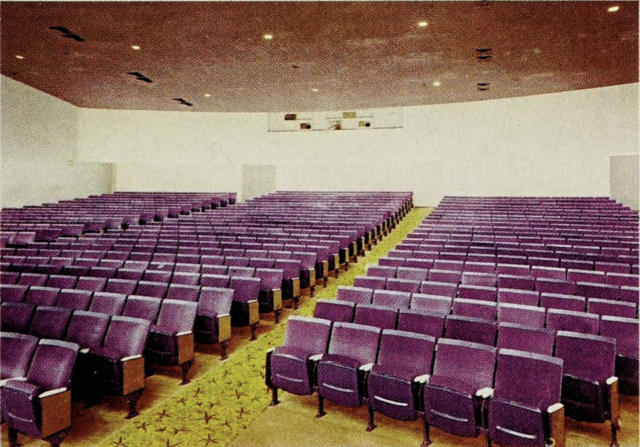
The original interior, May 1963, with somewhat over 800 seats.
This was prior to the installation of the Cinerama screen,
and the left and right booths do not yet have porthole windows.
I discover, only now, that it opened with 70mm on a flat screen.
Three booths were already built for eventual Cinerama installation,
but the Cinerama screen and equipment were not installed until a year later, in April 1964.
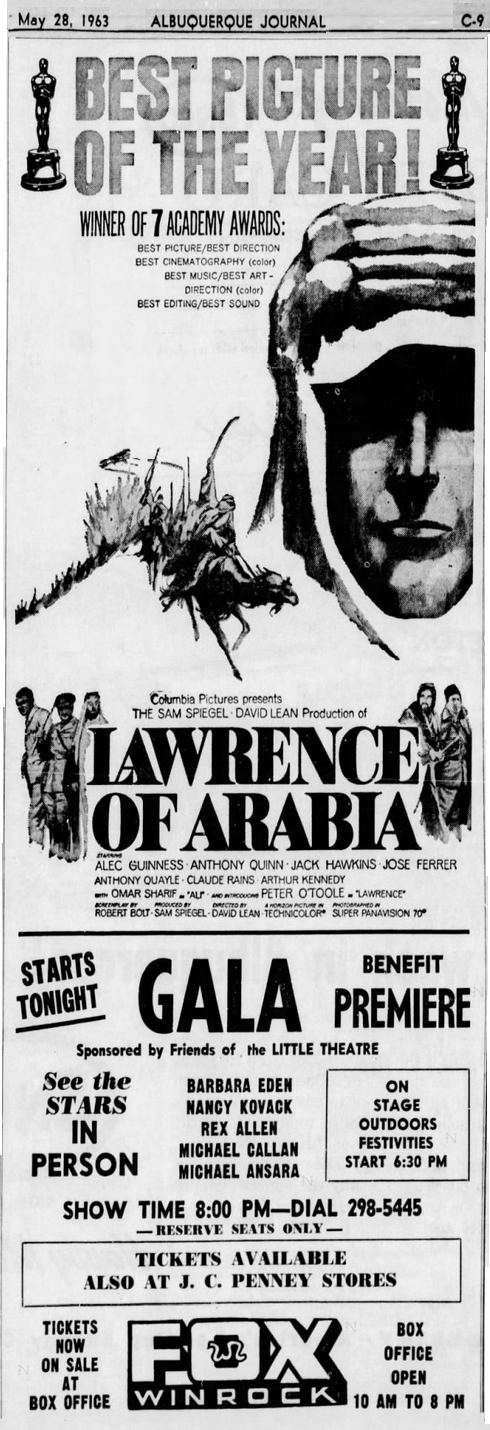
When a cinema is named Fox, we all understand that it is named after
William Fox of
Fox Film,
which was later gobbled up by the upstart
Twentieth Century Pictures.
The Fox Winrock was an exception — sort of.
With
United States v. Paramount Pictures, Inc., 334 U.S. 131 (1948),
all Hollywood studios, including 20th Century-Fox ,
were required to divest themselves of their cinema chains.
The Fox chain was spun off into
National General Corporation,
which in turn spun off a subsidiary called
Fox Intermountain Theatres, Inc., of Denver,
which built and owned and operated the Fox Winrock.
That’s where the name comes from.
I first attended the Fox Winrock for Play It Again, Sam
in July 1972.
My mother accompanied me and she hated the flick.
My memory is that it had a few laughs and that the cinematography, design, lighting were all dazzling.
The screen had a slight curvature, but it did not match the curtain rails.
I remember sitting in the middle of the auditorium, and the curtains opened, and opened, and opened, and then they were behind me and still opening,
finally revealing a horseshoe of about 150 degrees.
The screen, though, was the regular rectangle, nearly flat.
That was my first and last visit for another six years, if memory serves.
(For no reason other than the satisfaction of recording a memory:
I remember two previews ahead of the feature.
One was a preview for Frenzy, but not the one I find on YouTube.
It opened with Hitchcock entering a store and telling the clerk,
“I’d like to purchase a necktie.
It’s for a friend of mine.
He strangles people with them.”
That got a little laugh.
The other was a preview for Hannie Caulder.
There are, of course, several previews for that movie.
We saw this one.)
I do remember that it was in about 1978
that there was a news report that the Fox was being split in half to become a twin cinema.
The conversion took a whopping two days.
Bad idea, I thought, but the singular ingredient of nearly every moment of history is the bad idea.
Heck, civilization itself is a bad idea.
So what else is new?
It was in about June or July 1978 that I just wandered in again, for the first time since 1972.
At the urging of friends, I had decided to watch Heaven Can Wait.
So I bought my ticket and decided, what the heck?
I asked if I could chat with the projectionist.
Sure. No problem.
So I was escorted to what was left of the projection booth.
The projectionist was Bill Saylor, a huge guy who was a walking encyclopedia, especially about airplanes.
We were in the booth for Screen One, and there were the two Todd-AO
Norelco AA-II machines.
Beautiful things. I had never seen such machines before.
Bill was bemoaning the new xenon lamphouses.
He said that he had tried to explain to management that xenon cannot give proper coverage to the 70mm frame.
His appeal fell onto deaf ears.
Also, he objected to having the magazines removed.
The magazines could hold only 5,000' reels, but management insisted upon 6,000' reels.
Bill offered to trim the 6,000' reels to 5,000', but management would not hear of it.
So there he was, with 70mm machines, knowing that they would never run 70mm again, but only 35mm.
He told me a story of a school teacher of his acquaintance, who taught filmmaking class in junior-high (was it the teacher whose class I had unwillingly attended?).
She had asked him for a sample reel of film to show to her class.
So he handed her a reel of 35mm, and she was “flabbergasted.”
She had been expecting Super 8.
Then, to top that off, he handed her a small piece of 70mm, and she was speechless.
I had to chuckle.
Bill went on, telling me about the original three projection booths for Cinerama, which were cut off now, and so he couldn’t show them to me.
He was also unhappy about the building having been twinned.
Bill continued, showing off his Norelco machines, saying that most projectionists raved about their Simplexes and Centuries,
which could fit into a small corner of his beautiful Norelco machines, but he preferred Norelco above all.
He asked if I had ever seen 70mm film, and, of course, I had not.
So he looked up at a shelf, pulled down a roll of 70mm that was about 300 feet long,
unrolled it a little bit, and said, “Oh. This is Lawrence of Arabia.
That’s Jack Hawkins and I can’t remember the name of that other guy.” (It was Anthony Quayle.)
“You want some?”
“Sure!”
So he trimmed off a few frames from the end of that roll.
My memory was that it was eight frames, but my memory was wrong. It was three frames. It was the tail end of this scene:
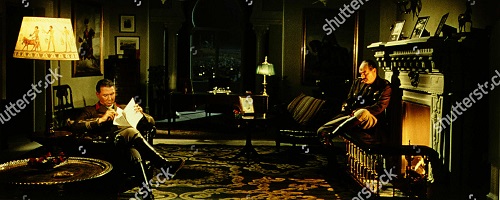
This particular frame is earlier in the scene.
The frames that Bill handed me were the final few frames,
a different angle, showing both Jack and Anthony in front of the fireplace.
Bill then took me to the other projection booth, Screen Two, just on the other side of a doorway.
That was also a 35/70mm machine, but running on a platter, and it was showing Heaven Can Wait,
which, I mentioned, I had heard was quite good, comparable to a Capra film.
Bill muttered, grouchily, something to the effect that, “It’s too ham-fisted to compare with Capra.”
Now, my memory here is completely wrong.
My memory is that Bill told me that the Screen Two projector was a Powers Cameragraph.
Something in my cocoanut got mixed up.
I later read about the Powers Cameragraph in F.H. Richardson’s Motion Picture Handbook of 1915,
and it bore no resemblance whatever to that modern machine I had seen at the Fox.
So, what that machine at the Fox was, I do not know, but it was a bit intimidating.
I’m searching the Internet for anything that resembles my memory.
Maybe it was a
Fedi?
Whatever it was, I have never seen another machine like it.
Bill also said he was planning on making a movie in Super 8.
“Why Super 8?” I asked.
Super 8 can only be shown in a living room, not in a cinema.
He had his reasons.
After all, even Steven Spielberg had begun by shooting Super 8.
I had to ask, “Who’s that?”
“He made Jaws.”
“Oh.”
Bill, though, was not going to make any old kind of Super 8 movie.
He was going to attach three Super 8 cameras to a single platform and shoot Super 8 Cinerama.
I wonder if he ever did that.
If so, I’d love to see the result.
I attended again for a reissue of Fantasia (Screen One, 28 October 1978).
I didn’t have a penny to my name, and so I was hoping that I could chat with Bill and see if he would wave me in.
I saw him by the concession stand and said “Hi,” but he was worried about something.
“You didn’t ask if you could go to the booth, did you?”
“No.”
He couldn’t wave me in, but, mysteriously, an usher waved me in.
A complete stranger, but he just waved me in. Just like that.
I was irritated that the seats were still facing the old screen.
The same problem had prevailed in Screen Two, and it had never been fixed.
The projection booth was still in the old center, which caused a bothersome right-to-left keystone.
I wanted to see the movie primarily because I wanted to hear the stereo sound, but just as the movie began,
so did the noisy air conditioning, which drowned out much of the soundtrack.
I could hear enough, though, to determine that the surround channel was only on the left side, since the right side was now in Screen Two.
Management had never added the surround speakers to the dividing wall!
Later, I saw four more movies there, also on Screen One,
Life of Brian (26 October 1979, pretty good),
The Shining (13 June 1980, ugh), and
Melvin and Howard (must have been 13 February 1981, cute movie), and
Merry Christmas, Mr. Lawrence (30 September 1983, historical nonsense, but nice anyway).
Life of Brian was hard-matted in the printer at 1:1.75 or maybe 1:1.85,
and Merry Christmas, Mr. Lawrence was hard-matted in the printer at 1:1.85.
The result on screen was terrible:
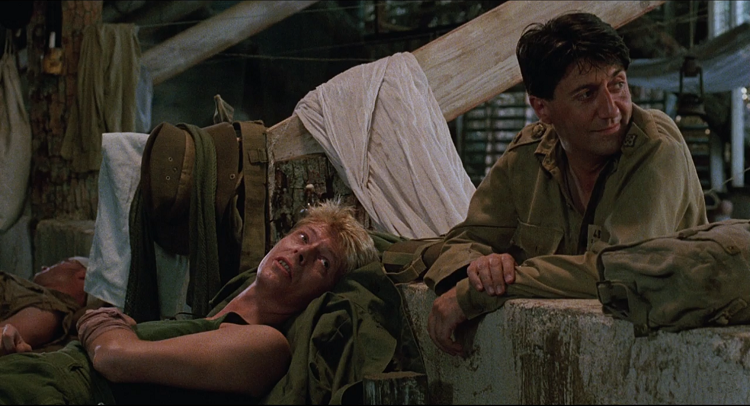
Above is correct.
Below is about how it looked at the Fox Screen 1.
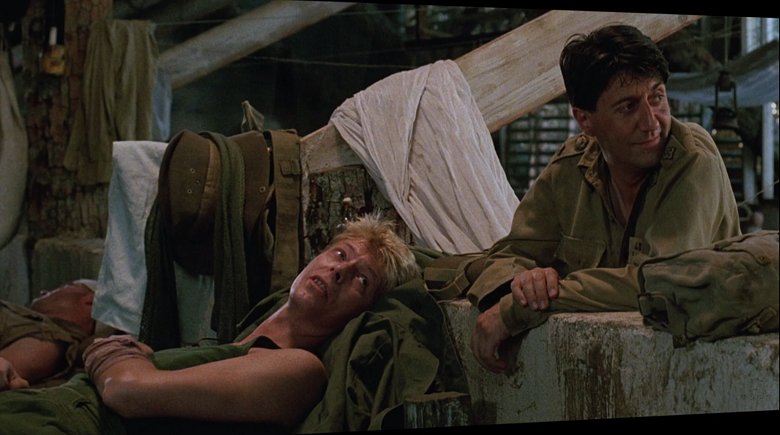
Nobody noticed. Nobody cared.
Horrible presentations we had in Albuquerque. Horrible — but no worse than in most other places on the planet.
Not long afterwards, I visited Rudy Napoleone in the booth of the Louisiana Blvd I-II-III ,
and he was beside himself with enthusiasm, because Screen One had just inherited one of the two Norelco AA-II’s
from the Fox Winrock. He loved that machine, and he seemed to be happy about now running on platters.
He asked, “You want some 70mm?” as he pulled a roll of about 300' from his work bench right by the Norelco.
I recognized it, and replied, “Bill Saylor gave me a few frames from that already.”
“Well take a few more!” he exclaimed, as he chopped a few frames from the other end of the shot,
the first few frames of the scene, which resembled the frame grab above.
I took it, a bit mystified.
Lawrence of Arabia then popped up on local TV, Channel 23 I think,
and I watched it, wanting to see that scene by the fireplace.
It was not there.
Not long afterwards, the Fox was no longer there either.
It had been demolished to make way for a six-plex. Darn!
The scene not being there now made sense.
The reason it was still on the shelf in the Fox projection booth fourteen years later was simply that the studio had ordered the scene deleted.
This happens with new movies.
It is nothing startling, nothing out of the ordinary.
The film arrived at the Fox, and Columbia sent word over to chop that scene out.
More likely, a local Columbia representative showed up and chopped it out himself.
After I moved to Buffalo, I read somewhere (Boxoffice? American Cinematographer? some other magazine?)
that Bob Harris and his partner Jim Katz had just restored Lawrence of Arabia,
and that, for the scene by the fireplace, the original six-track mag sound was missing.
All they could find was a monaural 35mm copy, which they enhanced with minor effects for the other five tracks.
They also spoke of how they had to re-create some missing scenes by retrieving outtakes,
and that they even had to have some of the actors revoice their parts.
Despite the imperfections, the film was now complete again, at long last.
They made it clear that they were happy to hear from anybody who might know of any further material.
I took that seriously, looked up their phone number, and made a call.
I reached a secretary, and as soon as I said I had a lead about more material for Lawrence of Arabia
she transferred me, and a nanosecond later Bob was on the line, impatiently demanding to know more.
I told him the above story.
When I mentioned that Bill Saylor had chopped out some frames for me, he groaned.
I mentioned that this happened at the Fox Cinerama, which by then had been twinned and was just the Fox.
He didn’t even need to wander to the other end of the room.
He already had his notes in front of him, as though he had been expecting my call,
and I could hear him turning pages quickly.
He exclaimed that “It did not play at the Fox in Albuquerque; it played at the Winrock!”
“It’s the same thing!” I explained. “The Fox was in the Winrock Shopping Center.”
“It played at the Winrock, not at the Fox!” he insisted.
Bob also saw in his notes, “That scene was already gone before the film got to Albuquerque!”
Perhaps it was, but nonetheless, I had held it in my hands, and Bill Saylor had recognized it immediately.
Disbelieving my claim, Bob concluded the call with quite some irritation in his voice,
saying that if I could ever find those frames, to let him know the edge numbers.
Okay, I agreed, but I could not find that clip after several hectic moves.
I went to see the restoration of the movie, and, to my astonishment, the fireplace scene was nowhere close to 300' long.
It was maybe 100' at the most.
So why do I remember that roll as being about 300'?
Was my memory that bad? Or was that roll spliced together with other things?
If it was spliced together with other things, then why was the beginning of the fireplace scene at one end and the ending at the other end?
My guess is that I had seen only a 100' roll, but I do not and cannot know.
I phoned Rudy Napoleone at the Louisiana Blvd I-II-III and reminded him of that encounter of some years earlier.
He had no memory of it at all.
I asked if he still had that roll of 70mm.
He did not remember it at all, but he did remember that whatever 70mm rolls they had, they recorded pink noise over so that they could do sound checks.
He found a roll that had a scene that he thought matched my description, and he mailed me a few frames, but it was entirely different.
I think it showed some elaborate banquet with lots of people.
I did not recognize what movie it was from.
I purchased a VHS of Lawrence of Arabia, made a copy of the fireplace scene, and mailed it to him.
No response.
After another few hectic moves (late 1998), I found one of those two little strips of film!
It was not the eight frames that I remembered, but only three, and it included an edge code!!!!!
I sent it by certified mail to Bob Harris, together with a letter recapitulating our previous conversation.
He signed the little green return receipt, but he never responded.
Now you know one of the ways movies are lost.
I don’t want to work in showbiz anymore.
I decided that I generally dislike showbiz people.
I have a different job now, and a different life.
I no longer freebase showbiz, or imbibe it or inhale it or inject it.
It’s an awful addiction.
I still write about it, though, and even writing about it can earn one threats and enemies.
Text: Copyright © 2019–2021, Ranjit Sandhu.
Images: Various copyrights, but reproduction here should qualify as fair use.
If you own any of these images, please contact me.
Images: Various copyrights, but reproduction here should qualify as fair use.
If you own any of these images, please contact me.